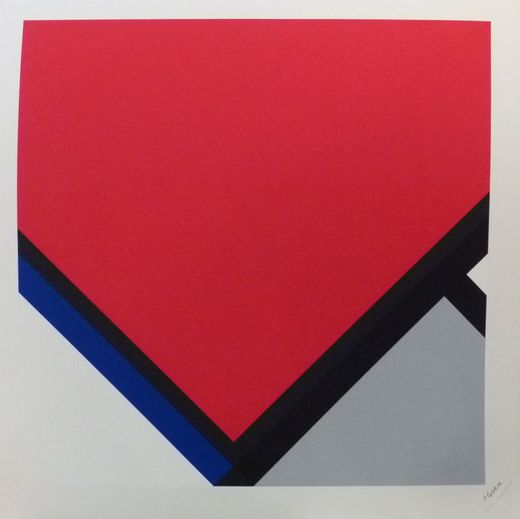

Biography
Albert Jean Gorin, known as Jean Gorin, is a French artist, born in 1899 in Saint-Émilien-de-Blain and died in 1981 in Niort.
Mondrian said of Jean Gorin, thirty years his junior, that he was "the only French neoplastician". But if the latter never missed an opportunity to assert his debt to the Dutch master, today we can regret that the recognition of his work has suffered somewhat from this sponsorship. We must indeed distinguish between his first neoplastic canvases (1926), still very close to Mondrian's painting, and his first sculptures, his first reliefs of the years 1928-1930, which are among the most elegant contributions to the constructivist side of twentieth century art. Mondrian himself was not mistaken, who strongly encouraged Gorin to continue in this direction, going so far as to write to him, in a letter full of friendship, "it is beyond my work, which remains still "table" background ".
During a trip to Paris, he saw Cubist paintings for the first time; back in Brittany, he devours the book by Gleizes and Metzinger (Du cubisme), reading which is his road to Damascus. In 1925, at the Decorative Arts Exhibition, it is the meeting not only of the architecture of Le Corbusier, but also of his painting (purism) as well as that of Léger, two parallel approaches including his first abstract works. synthesize. In 1926, he discovered an issue of Vouloir, a small review in Lille, which contained an article by Mondrian and reproductions of his paintings. The same journal informed him of the research of Vantongerloo, with whom he immediately entered into correspondence, curious to know more about his differences with Mondrian as to the theory of colors.
Today it is difficult to imagine the working conditions of Jean Gorin at that time, which are heroism, and to imagine his absolute solitude. Forced, for economic reasons, to live far from Paris, enthusiastic about the little he knows about neoplasticism, he decides to visit Mondrian in 1927. This meeting will leave him with an indelible memory. Back in Nort-sur-Erdre, he modifies his studio to make it, like Mondrian's, a neo-plastic interior. He returned from his trip to Paris with the idea of an expansion in the space of pictorial neoplasticism and this is what founds the originality of his work. But much more than in architecture (he draws many projects that will not be realized), it is in sculpture that Jean Gorin explores the three-dimensional space.
His first sculpted works, unfortunately mostly destroyed, form one of the richest interpretations of neoplasticism: by the intersection of cantilevered rectangular planes, they fix the surrounding space by figuring its coordinates, thus generating an impression of perpetual oscillation between centripetal and centrifugal movements; moreover, the polychromy (still very rare at the time) accentuates this virtual kineticism by constantly tilting the planes into each other, accentuating their recession or their protrusion. Becoming more complex and more openwork during the 1930s and 1940s, Gorin's sculpture ended up abandoning the exclusive use of colored planes, adding to them that of lines in space, black or white. From 1950, his best sculptures consisted of a linear framework on which are fixed color planes that stretch towards the four cardinal points.
Although Gorin produced an important pictorial work (canvases and architectural projects constitute the main part of his first personal exhibition, in Nantes, in 1928), his other favorite field is the art of relief, which allows him to deal with in sculpture of pictorial problems. His first reliefs are hollow "paintings" (1930): the lines which separate the rectangles of the neoplastic composition are no longer black but white and in the shade, set back a few millimeters from the plane of the painting. Then he adds lines in relief, black or colored, which create a layering of the planes in depth, a laminate which becomes more and more complicated and thick (Composition spatio-temporelle no 9, 1934). Colored planes are then grafted onto these protruding lines: the relief gradually becomes a sculpture in its own right (some of these works can be seen in two ways: placed on the ground or fixed to the wall).
1928, Lille: Neoplastic works with the Stuca group
1929-1930: Exhibition with the Cercle et Carré group created by Michel Seuphor and Joaquín Torres García.
1930, Nantes: Invited by the artistic group L'Etrave
1931, Paris: Exhibition of his first relief in an exhibition of the 1940 group
1945, Paris: Concrete Art Exhibition, Galerie René Drouin.
1946: Salon des Réalités Nouvelles, of which he is the secretary
1948, New York: Constructive Abstract Art Exhibition
1957, Paris: 50 years of abstract painting organized at Galerie Creuze, first private exhibition at Galerie Colette Allendy
1958, Saint-Étienne: The first generations of abstract art
1960, Liège: Museum of Walloon Art
1965, Nantes: Retrospective (1921-1965) at the Museum of Fine Arts
1966, Chicago: Exhibition at the Kazimir Gallery
1967, Amsterdam: Retrospective at the Stedelijk Museum
1969, Paris: Retrospective at the National Center for Contemporary Art
1974, Paris: Exhibition at the Galerie Denise René
1977, Nantes: Retrospective at the Museum of Fine Arts
1977, Paris: Center Pompidou
1999, Blain: Homage of the Madi movement to Gorin, Château de la Groulais
1999, Grenoble: Jean Gorin exhibition.
Nationality
Themes




